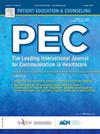Asking about drug allergies: Managing antimicrobial medicines-related risks in primary care in England and Sweden
IF 3.1
2区 医学
Q2 PUBLIC, ENVIRONMENTAL & OCCUPATIONAL HEALTH
引用次数: 0
Abstract
Objective
Penicillins are the most common cause of drug-induced anaphylaxis worldwide, yet penicillin allergy status is seldom clinically tested and therefore reliant on patient report. Managing risk of harm is fraught with uncertainties: patients may not always be truly allergic and medical records may not be accurate. The aim of this study was to investigate how conversations about drug allergy risks unfold when prescribing for common infections.
Method
We screened 156 acute primary care consultations for adult patients presenting with upper respiratory concerns in England and Sweden to identify all cases where drug allergies were raised. Data are in British English and Swedish. We used conversation-analytic methods to make systematic observations on how the topic was initiated; the activity context; the patient’s response and any subsequent mention of drug allergy; identifying recurrent patterns within and across the two datasets.
Results
In both datasets, drug allergies were raised in just over one third of consultations most often via questions conveying a bias towards a ‘no allergy’ outcome. When asked during information-gathering, the question was sometimes misunderstood as asking about allergies in general. In the majority of cases, no allergies were reported, yet patients often qualified their ‘no allergy’ answers displaying uncertainty. Patients who did report allergies were seldom questioned about the nature of their symptoms. Where patient allergy status was contested or neglected by doctors and brought to the interactional surface, work was done by both parties to maintain neutrality or display cautiousness around different territories of knowledge.
Conclusion
Our analysis reveals common interactional problems faced by prescribing professionals when managing the risk of patient harm from drug allergies when recommending antimicrobials.
Practice Implications
This study has provided pre-intervention evidence for how drug allergy checking can be improved. Other simple changes may help to identify low-risk individuals for future testing.
询问药物过敏:管理英格兰和瑞典初级保健中与抗菌药物相关的风险
目的青霉素是世界范围内引起药物性过敏反应的最常见原因,但青霉素过敏状况很少进行临床检测,因此依赖于患者报告。管理伤害风险充满了不确定性:患者可能并不总是真正的过敏,医疗记录也可能不准确。这项研究的目的是调查在为常见感染开处方时,关于药物过敏风险的对话是如何展开的。方法:我们筛选了英格兰和瑞典156例出现上呼吸道问题的成年患者的急性初级保健咨询,以确定所有提出药物过敏的病例。数据为英式英语和瑞典语。我们使用对话分析方法对话题是如何发起的进行了系统的观察;活动上下文;患者的反应和随后提及的任何药物过敏;识别两个数据集内部和之间的循环模式。结果在这两个数据集中,药物过敏在超过三分之一的咨询中被提出,最常见的是通过问题传达对“无过敏”结果的偏见。当在信息收集过程中被问到这个问题时,这个问题有时会被误解为一般的过敏问题。在大多数情况下,没有过敏的报告,但患者往往限定他们的“没有过敏”的答案显示不确定性。那些报告过敏的病人很少被问及他们症状的性质。当医生对患者的过敏状况有争议或忽视,并将其带到互动层面时,双方都要在不同的知识领域保持中立或谨慎。结论我们的分析揭示了处方专业人员在推荐抗菌素时在管理患者药物过敏伤害风险时面临的常见相互作用问题。实践意义本研究为如何改进药物过敏检查提供了干预前证据。其他一些简单的改变可能有助于确定未来检测的低风险个体。
本文章由计算机程序翻译,如有差异,请以英文原文为准。
求助全文
约1分钟内获得全文
求助全文
来源期刊

Patient Education and Counseling
医学-公共卫生、环境卫生与职业卫生
CiteScore
5.60
自引率
11.40%
发文量
384
审稿时长
46 days
期刊介绍:
Patient Education and Counseling is an interdisciplinary, international journal for patient education and health promotion researchers, managers and clinicians. The journal seeks to explore and elucidate the educational, counseling and communication models in health care. Its aim is to provide a forum for fundamental as well as applied research, and to promote the study of organizational issues involved with the delivery of patient education, counseling, health promotion services and training models in improving communication between providers and patients.
 求助内容:
求助内容: 应助结果提醒方式:
应助结果提醒方式:


